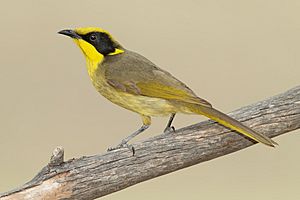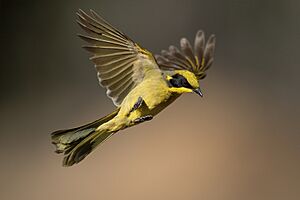Yellow-tufted honeyeater facts for kids
Quick facts for kids Yellow-tufted honeyeater |
|
|---|---|
 |
|
| Conservation status | |
| Scientific classification | |
| Genus: |
Lichenostomus
|
| Species: |
melanops
|
The yellow-tufted honeyeater (Lichenostomus melanops) is a small, active bird that lives in southeastern Australia. It's mostly black and yellow, and it belongs to a group of birds called honeyeaters. There are four different types, or subspecies, of this bird.
Contents
About the Yellow-tufted Honeyeater
Scientists use a system called binomial names to give every living thing a unique two-part name. The yellow-tufted honeyeater was first described in 1801 by an English bird expert named John Latham. He gave it the scientific name Lichenostomus melanops.
The name Lichenostomus comes from ancient Greek words meaning "lichen" and "mouth." The second part, melanops, means "black face." This name fits the bird well because of its black face mask. DNA studies show that honeyeaters are related to other Australian birds like pardalotes and Australasian robins.
Different Types of Yellow-tufted Honeyeaters
There are four recognized types, or subspecies, of the yellow-tufted honeyeater:
- Helmeted honeyeater (L. m. cassidix): This is the brightest and largest subspecies. It weighs about 28 to 32 grams (1 ounce). It lives in a very small area near Melbourne, Victoria. In 2003, there were only 103 of these birds left in the wild. Some are also cared for at the Healesville Sanctuary.
- Gippsland yellow-tufted honeyeater (L. m. gippslandicus)
- Sydney yellow-tufted honeyeater (L. m. melanops)
- Inland yellow-tufted honeyeater (L. m. meltoni): This type is smaller and not as brightly colored. It also has a smaller "tuft" of feathers.
What the Yellow-tufted Honeyeater Looks Like
The yellow-tufted honeyeater is about 17 to 23 centimeters (6.7 to 9 inches) long. Female birds are usually a bit smaller than males. This bird has a bright yellow forehead, the top of its head, and throat. It also has a shiny black mask around its eyes and bright golden ear-tufts.
Its back is olive-green, and its wings and tail are olive-brown. The feathers on its belly are more olive-yellow. The bird's beak and the skin around its mouth are black. Its eyes are brown, and its legs are grey-brown.
Where They Live and Their Home
The yellow-tufted honeyeater can be found in southeastern Queensland, eastern New South Wales, and across Victoria. They like to live in dry, open forests and woodlands. These areas often have eucalypt trees and a lot of shrubs. They also live in areas with mallee trees, brigalow, and cypress-pine trees.
The helmeted honeyeater subspecies has a very specific home. They prefer dense plants along riverbanks. These areas are often filled with mountain swamp gum trees and thick bushes like woolly tea-tree and scented paperbark. They also like areas with saw-sedge, ferns, and tussock grasses.
How Yellow-tufted Honeyeaters Behave
Yellow-tufted honeyeaters are noisy and very active birds. They often live in groups, called colonies, that can have from a few birds to up to a hundred. They are very protective of their areas, especially around flowering trees.
They make many different sounds. Some calls sound like a warbled "tui-t-tui-t-tui" or a whistled "wheit-wheit." They also have a sharp "querk" sound and a harsh "yip" or "chop-chop" call to communicate with each other.
What They Eat and How They Find Food
The yellow-tufted honeyeater mainly eats arthropods, which include various insects and spiders. Sometimes, they also eat snails. They enjoy eating sweet substances like lerps and honeydew, which are made by insects. They also drink nectar from flowers and sap from eucalypt trees. Occasionally, they will eat fruit and flowers.
They catch insects while flying or by looking for them in the bark of tree trunks and branches.
Reproduction and Life Cycle
Yellow-tufted honeyeaters usually breed between July and March, but mostly from September to January. They can have one or two groups of babies each season. Their nest is shaped like a cup. It's made from dried grasses, small pieces of bark, and other plant materials. They use spider webs to hold it all together and line it with fur and feathers. The nest hangs from its edge in thick bushes or new plant growth.
The female bird lays two or three eggs. Each egg is about 23 by 17 millimeters (0.9 by 0.7 inches). They are pinkish with pale reddish or buff-brown spots. The female bird usually sits on the eggs to keep them warm for 14 to 16 days. Once the babies hatch, the female feeds them, and the male and any helper birds also bring food. The young birds leave the nest when they are about 13 to 15 days old. They usually become independent by the time they are 6 weeks old. Sometimes, other birds like the fan-tailed cuckoo, pallid cuckoo, and shining bronze-cuckoo lay their eggs in the honeyeater's nest. This is called brood parasitism.
Protecting the Yellow-tufted Honeyeater
Overall, the yellow-tufted honeyeater species is not considered to be in danger in Australia. However, one of its subspecies, the helmeted honeyeater (L. m. cassidix), is in serious trouble.
- The helmeted honeyeater is listed as endangered under Australia's Environment Protection and Biodiversity Conservation Act 1999. This means it is at very high risk of disappearing forever.
- It is also listed as threatened in Victoria under the Flora and Fauna Guarantee Act (1988). This law helps create plans to protect and manage the species.
- In 2007, the helmeted honeyeater was listed as critically endangered in Victoria. This is the highest level of threat.
Efforts are being made to protect this special bird and help its population grow.
See also
 In Spanish: Mielero orejigualdo para niños
In Spanish: Mielero orejigualdo para niños



